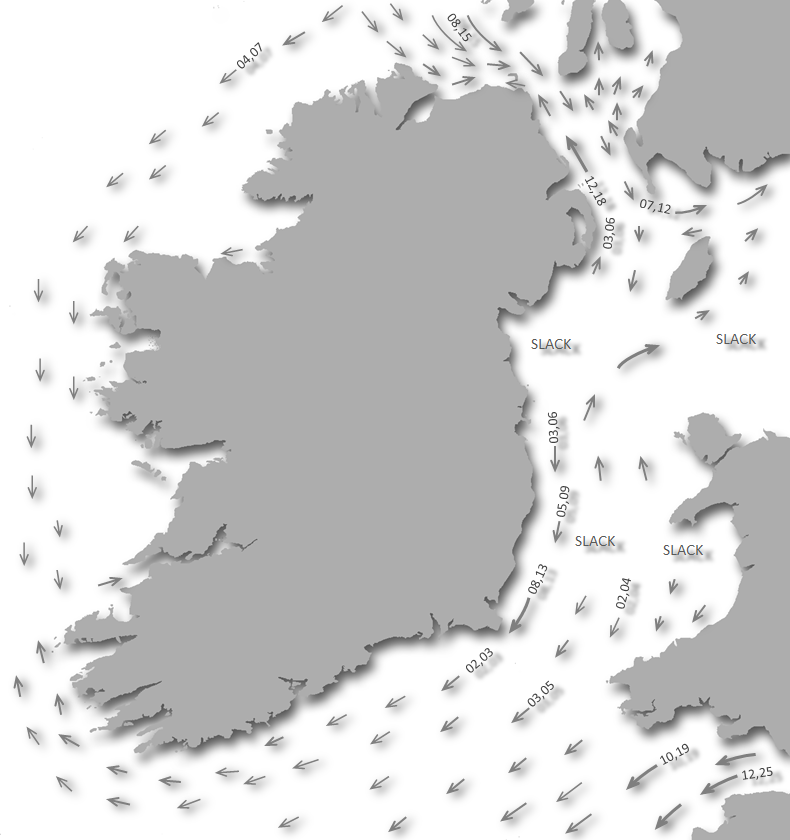
This is a good anchorage offering all-round protection except for north around to northwesterly winds and it offers particularly good protection from southerlies. The Lough's enclosed body of water provides sheltered sailing in all weather, all tides and ample marks to make daylight navigation straightforward.
Keyfacts for Jackdaw Island
Facilities

Nature




Considerations

Protected sectors
Approaches


Shelter


Last modified
November 7th 2022 Summary
A good location with attentive navigation required for access.Facilities

Nature




Considerations

Position and approaches
Expand to new tab or fullscreen
Haven position
 54° 22.968' N, 005° 36.538' W
54° 22.968' N, 005° 36.538' W200 metres west of Jackdaw Island.
What is the initial fix?
The following Chapel Island & Jackdaw Islands Initial Fix will set up a final approach:
 54° 23.368' N, 005° 35.970' W
54° 23.368' N, 005° 35.970' W What are the key points of the approach?
Offshore details for vessels approaching Strangford Lough from the north are available in northeast Ireland’s coastal overview for Malin Head to Strangford Lough  . Details for vessels approaching from the south are available in eastern Ireland’s coastal overview for Strangford Lough to Dublin Bay
. Details for vessels approaching from the south are available in eastern Ireland’s coastal overview for Strangford Lough to Dublin Bay  . Details of the approaches, tidal timings, the run up The Narrows and onward to Killyleagh, on the Lough's western shore, are covered in the Entering and exiting Strangford Lough
. Details of the approaches, tidal timings, the run up The Narrows and onward to Killyleagh, on the Lough's western shore, are covered in the Entering and exiting Strangford Lough  route description.
route description.
 . Details for vessels approaching from the south are available in eastern Ireland’s coastal overview for Strangford Lough to Dublin Bay
. Details for vessels approaching from the south are available in eastern Ireland’s coastal overview for Strangford Lough to Dublin Bay  . Details of the approaches, tidal timings, the run up The Narrows and onward to Killyleagh, on the Lough's western shore, are covered in the Entering and exiting Strangford Lough
. Details of the approaches, tidal timings, the run up The Narrows and onward to Killyleagh, on the Lough's western shore, are covered in the Entering and exiting Strangford Lough  route description.
route description.Not what you need?
Click the 'Next' and 'Previous' buttons to progress through neighbouring havens in a coastal 'clockwise' or 'anti-clockwise' sequence. Below are the ten nearest havens to Jackdaw Island for your convenience.
Ten nearest havens by straight line charted distance and bearing:
- Between Jackdaw & Chapel Island - 0.3 nautical miles ENE
- Chapel Island - 0.5 nautical miles E
- Audley’s Point - 1 nautical miles E
- Salt Island (South) - 1.3 nautical miles WSW
- Audley's Roads - 1.4 nautical miles E
- Brandy Bay (North Salt Island) - 1.5 nautical miles W
- Killyleagh - 1.6 nautical miles WNW
- Ballyhenry Bay - 1.6 nautical miles ENE
- Salt Island (Southwest) - 1.6 nautical miles WSW
- Don O’Neill Island - 1.7 nautical miles NNW
These havens are ordered by straight line charted distance and bearing, and can be reordered by compass direction or coastal sequence:
- Between Jackdaw & Chapel Island - 0.3 miles ENE
- Chapel Island - 0.5 miles E
- Audley’s Point - 1 miles E
- Salt Island (South) - 1.3 miles WSW
- Audley's Roads - 1.4 miles E
- Brandy Bay (North Salt Island) - 1.5 miles W
- Killyleagh - 1.6 miles WNW
- Ballyhenry Bay - 1.6 miles ENE
- Salt Island (Southwest) - 1.6 miles WSW
- Don O’Neill Island - 1.7 miles NNW
Chart
What's the story here?
 Jackdaw Island as seen from the anchorage
Jackdaw Island as seen from the anchorageImage: Michael Harpur
The small uninhabited Jackdaw Island is the western islet of the two easternmost islands on the southern shore of Strangford Lough. It lies a ¼ of a mile off the shoreline and is an almost square islet that is about 160 metres wide with a hummock at about its centre that rises to 10 metres. The shoreline dries out to the island and the surrounding shores of the island dry out to about 25 metres.
There is 2.4 metres LAT westward of the island where good holding will be found.
How to get in?
 Jackdaw Island is about a little over a mile westward of Audley's Point
Jackdaw Island is about a little over a mile westward of Audley's Point Image: Michael Harpur
 Details of the approaches, tidal timings, the run up The Narrows and onward to Killyleagh, on the Lough's western shore, are covered in the Entering and exiting Strangford Lough
Details of the approaches, tidal timings, the run up The Narrows and onward to Killyleagh, on the Lough's western shore, are covered in the Entering and exiting Strangford Lough  route description. Jackdaw Island is a little over a mile westward of Audley Point.
route description. Jackdaw Island is a little over a mile westward of Audley Point. The Chapel & Jackdaw Islands Initial Fix places the vessel 300 metres north of Chapel Island where both islands will be visible and it is a simple matter of passing around Jackdaw Island.
The Chapel & Jackdaw Islands Initial Fix places the vessel 300 metres north of Chapel Island where both islands will be visible and it is a simple matter of passing around Jackdaw Island. Anchor westward of Jackdaw Island
Anchor westward of Jackdaw IslandImage: Michael Harpur
 Anchor according to draft and conditions over sand and shale with good holding.
Anchor according to draft and conditions over sand and shale with good holding.Why visit here?
Unlike Chapel Island, Jackdaw Island has never been farmed and appears not to have been inhabited. But the location history of human inhabitation runs very deep here as one field in from the tidal mudflats around Jackdaw Island is the important Neolithic Audleystown Court Tomb. The position of Audleystown Court Tomb ashore
The position of Audleystown Court Tomb ashoreImage: Michael Harpur
Situated in a slight hollow overlooking the island the well-preserved tomb was built during the period 3900–3500 BCE. The cairn is orientated northeast-southwest, with the wider end facing southwest, and it has a double courtyard-double burial chamber layout which is unique to Ireland. Today it is faced with a drystone wall of standing shale stones, which in their time would have been covered by shale and earth. The court tomb was used for the burial of at least thirty men, women and children, along with bones of cattle, horses, sheep and pigs in two opposing galleries. There were also finds of pottery, a large javelin head, and scrapers and knives. Two of the bowls had lugs like vessels found in tombs in Scotland. Fingertip fluting on three bowls makes them similar to bowls found in Scotland and the Isle of Man. Its location on the shores of the Lough, directly overlooking Jackdaw Island and the estuary of the River Quoile suggests that some people saw themselves as being connected to the waters of particular sheltered bays and inlets. It is also historically interesting for being the site where the earliest known horse bones were found in Ireland.
 The Audleystown Double Horned Court Cairn
The Audleystown Double Horned Court CairnImage: Peter Moore via CC BY-SA 3.0
Nearby in a sub-denomination of the townland of Audleystown, called Tubberdoney, is the site of an early possible 5th-century Christian church called Temple Cormick - Cormac's Church. All that remains is a small ruined, dry-stone church of simple rectangular plan with a surrounding enclosure that marks the boundary of an ancient cemetery. Unfortunately, its history is lost save that Cormac was a particular friend of St Patrick who arrived here to bring Christianity to Ireland. Toberdoney, meaning Donard's Walls, possibly refers to another early Christian site that may have existed in this area and was dedicated to St Domangart or Donard.
 The drystone wall of standing shale stones
The drystone wall of standing shale stonesImage: Eric Jones via CC BY-SA 2.0
Today there is little activity save for birdlife on Jackdaw Island's tussock grass which is perhaps how it acquired its name. It is possible to land and go for a walk on Jackdaw, or indeed Chapel Island, from here. But please note that Jackdaw is an important nesting site for Sandwich Terns in the spring and should be avoided at that time. On the other hand, on a quiet day, tucked away from it all behind uninhabited Jackdaw Island, it is easy to immerse oneself in a peaceful location. Very little has changed at this location since Megalithic times and it is easy to cast the mind back even a thousand years to when Viking boats passed through close north of here. Most notably in 1002, and subsequently again in 1149, the sleek longboats came cutting through the Lough's peaceful waters, sharp-eyed crews tense with the anticipation of imminent battle and monastic plunder; bent on Quoile Abbey.
 Jackdaw Island with the entrance to the Quoile and the Mountains of Mourne in
Jackdaw Island with the entrance to the Quoile and the Mountains of Mourne inthe backdrop
Image: Michael Harpur
From a boating point of view today, it is a snug anchorage where a boat can take in views across the island-dotted Lough to the west or over the mistily distant Mourne Mountains to the south. It is a favourite location to watch the clubs of the Lough race as the much-used racing mark No.11 (Jackdaw) is located nearby and, with the sun behind, it is the perfect place to watch the action.
What facilities are available?
There are no facilities on Chapel and Jackdaw Islands or in the surrounding area.Any security concerns?
Never a problem known to have occurred around the isolated Chapel and Jackdaw Islands.With thanks to:
Brian Crawford, local Strangford Lough boatman of many decades. eOceanic would like to thank Quoile Yacht Club for hosting our survey boat during the survey of Strangford Lough.
for hosting our survey boat during the survey of Strangford Lough.Add your review or comment:
Please log in to leave a review of this haven.
Please note eOceanic makes no guarantee of the validity of this information, we have not visited this haven and do not have first-hand experience to qualify the data. Although the contributors are vetted by peer review as practised authorities, they are in no way, whatsoever, responsible for the accuracy of their contributions. It is essential that you thoroughly check the accuracy and suitability for your vessel of any waypoints offered in any context plus the precision of your GPS. Any data provided on this page is entirely used at your own risk and you must read our legal page if you view data on this site. Free to use sea charts courtesy of Navionics.












